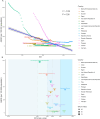Global, regional and national disease burden of food-borne trematodiases: projections to 2030 based on the Global Burden of Disease Study 2021
- PMID: 39676162
- PMCID: PMC11648293
- DOI: 10.1186/s40249-024-01265-6
Global, regional and national disease burden of food-borne trematodiases: projections to 2030 based on the Global Burden of Disease Study 2021
Abstract
Background: Food-borne trematodiases (FBTs), mainly encompassing clonorchiasis, fascioliasis, fasciolopsiasis, opisthorchiasis, and paragonimiasis, is a neglected public health problem, particularly in the WHO South-East Asia and the Western Pacific regions. This study evaluates the global, regional, and national disease burden of FBTs from 1990 to 2021 and projects trends to 2030, underscore the need for targeted prevention and control.
Methods: Using the Global Burden of Disease 2021 database, the crude and the age-standardized prevalence rate (ASPR) and age-standardized prevalence disability-adjusted life years rate (ASDR) of FBTs at the global, regional and national level from 1990 to 2021 were described. The pivotal years of trend changes were identified using joinpoint regression analysis. The effects of age, period, cohort on FBTs prevalence and correlation with the sociodemographic index (SDI) was analyzed. Finally, the worldwide disability-adjusted life years (DALYs) for FBTs, projected up to 2030 using the Bayesian age-period-cohort model, were analyzed.
Results: In 2021, 44,466,329 FBTs cases [95% uncertainty interval (UI): 40,017,217, 50,034,921], and 998,028 DALYs [95% UI: 569,766, 1,638,112] were estimated across 17 countries. The Western Pacific region exhibited the highest ASPR and ASDR, with the values of 1649.26 (95% UI: 1461.95, 1881.64) and 36.54 (95% UI: 19.77, 64.16), respectively. From 1990 to 2021, Lao PDR, Thailand, and the Philippines showed the most substantial declines in FBTs, while Kazakhstan had the largest average annual percentage change in DALYs (- 6.60, 95% UI: - 7.10, - 6.10). High-middle and middle SDI countries exhibited higher burden, with ASDR values of 28.03 (95% UI: 15.41, 48.73) and 16.63 (95% UI: 9.32, 27.68), respectively. The disease burden was greater among males, peaking in the 50-59 age group. The projected ASDR in 2030 is 13.10 for males and 8.40 for females.
Conclusions: FBTs remain a public health threat, with the global ASDR projected to remain stable, showing only a slight decrease by 2030. Low-income countries face ambiguous mortality rates and underestimated disease burdens, highlighting the need for improved surveillance. To achieve the 2030 NTD goal, comprehensive surveillance and integrated strategies derived using a One Health approach should be prioritized to control FBTs effectively.
Keywords: Bayesian age-period-cohort analysis model; Disease burden; Food-borne trematodiases.
© 2024. The Author(s).
Conflict of interest statement
Declarations. Ethics approval and consent to participate: Not applicable. Consent for publication: Not applicable. Competing interests: Xiao-Nong Zhou is an Editor-in-Chief of the journal Infectious Diseases of Poverty. Guo-jing Yang is an editor of the journal Infectious Diseases of Poverty. They were not involved in the peer-review or handling of the manuscript. The authors have no other competing interests to disclose.
Figures






Similar articles
-
Global, regional, and national burden of gastritis and duodenitis from 1990 to 2021 with projections to 2050: a systematic analysis of the Global Burden of Disease Study 2021.Int J Med Sci. 2025 May 10;22(11):2570-2582. doi: 10.7150/ijms.109762. eCollection 2025. Int J Med Sci. 2025. PMID: 40520897 Free PMC article.
-
The global, regional, and national burden of paralytic ileus and intestinal obstruction, 1990 to 2021: a cross-sectional analysis from the 2021 global burden of disease study.Int J Surg. 2025 Feb 1;111(2):1773-1787. doi: 10.1097/JS9.0000000000002189. Int J Surg. 2025. PMID: 39784557
-
The global, regional, and national brain and CNS cancers burden and trends from 1990 to 2021.Sci Rep. 2025 Jun 1;15(1):19228. doi: 10.1038/s41598-025-04636-7. Sci Rep. 2025. PMID: 40451904 Free PMC article.
-
Global prevalence of 4 neglected foodborne trematodes targeted for control by WHO: A scoping review to highlight the gaps.PLoS Negl Trop Dis. 2023 Mar 2;17(3):e0011073. doi: 10.1371/journal.pntd.0011073. eCollection 2023 Mar. PLoS Negl Trop Dis. 2023. PMID: 36862635 Free PMC article.
-
Global, regional, and national burden of 12 mental disorders in 204 countries and territories, 1990-2019: a systematic analysis for the Global Burden of Disease Study 2019.Lancet Psychiatry. 2022 Feb;9(2):137-150. doi: 10.1016/S2215-0366(21)00395-3. Epub 2022 Jan 10. Lancet Psychiatry. 2022. PMID: 35026139 Free PMC article.
Cited by
-
Global, regional, and national disability-adjusted life years and prevalence of lymphatic filariasis from 1990 to 2021: A trend and health inequality analysis based on the global burden of disease study 2021.PLoS Negl Trop Dis. 2025 Apr 29;19(4):e0013017. doi: 10.1371/journal.pntd.0013017. eCollection 2025 Apr. PLoS Negl Trop Dis. 2025. PMID: 40300002 Free PMC article.
-
Global, regional, and national burden of Visceral leishmaniasis, 1990-2021: findings from the global burden of disease study 2021.Parasit Vectors. 2025 Apr 26;18(1):157. doi: 10.1186/s13071-025-06796-x. Parasit Vectors. 2025. PMID: 40287729 Free PMC article.
-
Trend and forecast analysis of the changing disease burden of tuberculosis in China, 1990-2021.Epidemiol Infect. 2025 Jul 15;153:e85. doi: 10.1017/S0950268825100095. Epidemiol Infect. 2025. PMID: 40660500 Free PMC article.
-
Molluscicidal activities of Senna alata silver nanoparticles against adult and egg stages of Lymnaea natalensis.Sci Rep. 2025 Jul 16;15(1):25746. doi: 10.1038/s41598-025-11771-8. Sci Rep. 2025. PMID: 40670584 Free PMC article.
References
-
- World Health Organization. Ending the neglect to attain the sustainable development goals: a road map for neglected tropical diseases 2021–2030. Geneva: World Health Organization, 2020. https://iris.who.int/handle/10665/338565. Accessed 9 July, 2024.
-
- International Agency for Research on Cancer: a review of human carcinogens part b: biological agents. IARC monographs on the evaluation of carcinogenic risks to humans. 2011, Lyon: IARC.
MeSH terms
Grants and funding
LinkOut - more resources
Full Text Sources

